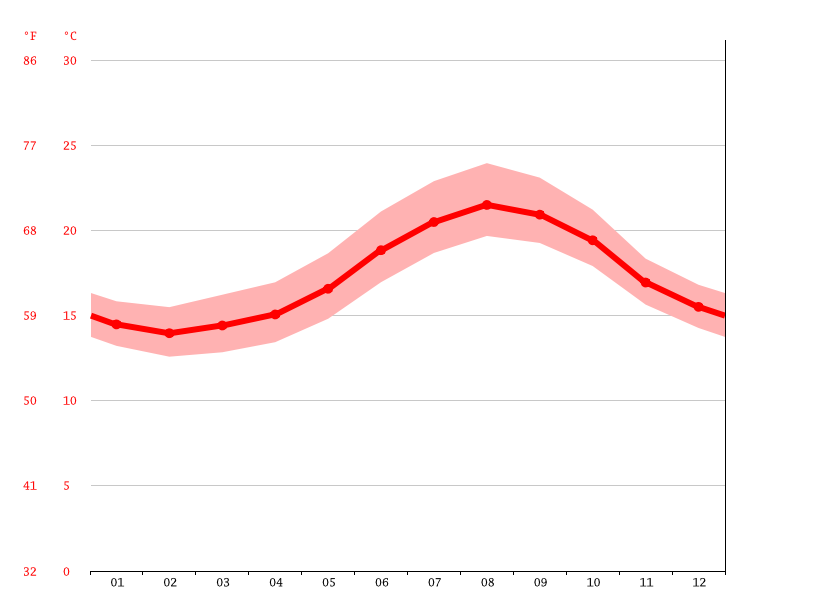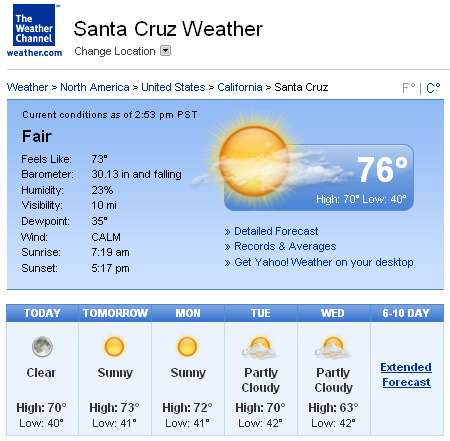
NClimDiv Overview SlideDeck Population Datasets Dataset Description USAFacts: Monthly (14th of every month) Relevant Dataset Documentation and Links Source Agency: Monthly (within first week of each month)
#WEATHER SANTA CRUZ MONTHLY UPDATE#
N = Number of Months Represented Expected Dataset Update Frequency The use of a two standard deviation cut-off point, which places approximately 95% of observations into the “average” categorization means that months categorized as “warmer,” “cooler,” “wetter,” and “drier” represent rarer than once-in-20-year events.Ī standard deviation measures the amount of variability among the numbers in a data set, the typical distance of a data point from the mean of the data and is calculated against the NClimDiv data as: This bucket categorization is critical to eliminate data noise as regional geographies experience natural fluctuations in temperature and precipitation from year to year.Īlthough the threshold for what is considered extreme weather differs across research and government organizations, we used a standardized baseline to classify approximately 95% of 20th century events as average.

All values that fell below or above two standard deviations are defined as climatic anomalies cooler/wetter than or warmer/drier than the historical norm, respectively. We defined all monthly temperature and precipitation values to be average in comparison to the 20th century average if they fell within two standard deviations of the 20th century average. The transformations to these climatic data were done to provide users with an intuitive understanding of whether a given month’s total precipitation or average temperature were similar to or different than the corresponding historical average. Like Alaska, such data limitations required us to constrict our “20th century averages” to the years available. Although data for Honolulu are available from 1890 onward, data for Lihue and Kahului are limited to 1905 forward and Hilo data are limited to 1949 forward, with certain transitory phases during station maintenance also missing data. Hawaii County is represented by the weather station in Hilo, Maui County by Kahului, Honolulu County by Honolulu, and Kauai County by Lihue. These averages are consistent with accepted baseline measures that major governmental and scientific sources use as a point of comparison over long time horizons 2, 3.Īlaska data was limited to 1925 forward therefore our “20th century average” for Alaska is based on the known 75-year time span.įor Hawaiian data, data are limited to a single weather station for each of the state’s four largest counties: Hawaii, Maui, Kauai, and Honolulu. Such methodology was applicable to all counties in the contiguous United States. This provided the average, which was subsequently used to calculate the standard deviation for each county-month pairing. We reconstructed these averages to verify that we were using the proper methodology and then applied that methodology to the county-level monthly average dataset. These averages are specific to each county and month. NCEI references these averages as varieties of climate normals, we will reference these values as average.

The NClimDiv database hosts multiple types of historical averages: 30-year averages starting from 1901, 1895-2010 average, and 20th century average, the latter is being used in this experience. Although presented side-by-side with the county-level averages, the Hawaiian data are station-specific averages and should not be considered representative of county-level climate. To provide a comprehensive account of climate across the United States, we supplemented the dataset with individual station data for each county in Hawaii. Those data exclude Hawaii because NCEI indicated county-level averages could not be constructed with the limited data and highly variable climate patterns of the Hawaiian Islands. We leveraged the county-level temperature and precipitation averages to showcase climatic anomalies in comparison to the 20th century average. Its NOAA Monthly US Climate Divisional Database (NClimDiv) 1 provides data for temperature, precipitation, drought indices, and heating and cooling degree days for US climate divisions, states, multi-state regions, and the nation from 1895 to the present. The National Centers for Environmental Information (NCEI), is a sub-bureau of the National Oceanic and Atmospheric Administration (NOAA).

Data Methodology Temperature and Precipitation Datasets Dataset Description


 0 kommentar(er)
0 kommentar(er)
